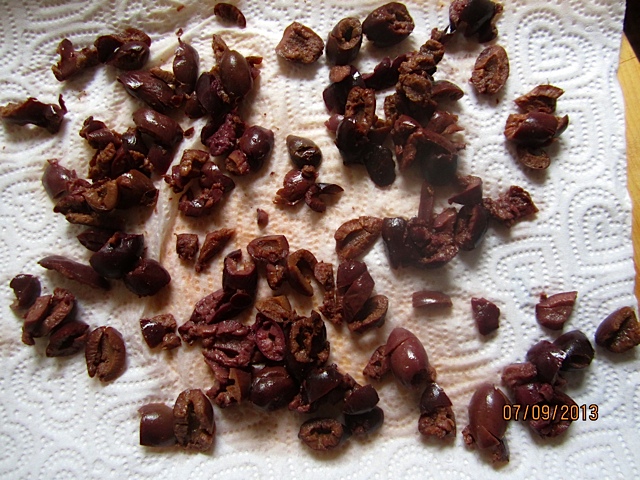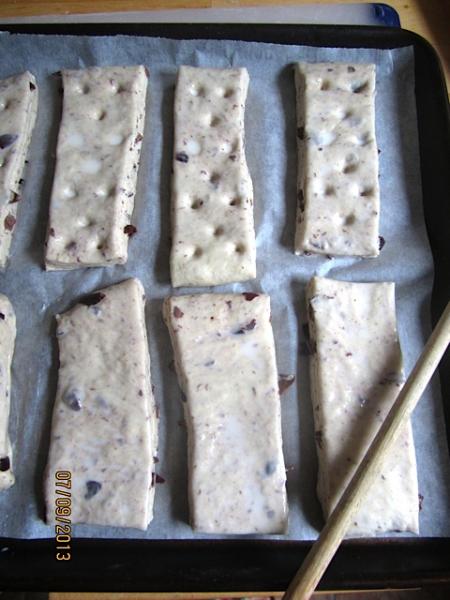There are two things members of our patchwork family have in common - we love good food and we hate olives!
Even the pickiest of our kids, Valerie, producer of the famous "square mouth" whenever I made her try at least one bite before she said she didn't like it; and Francesca who ordered "just white rice" when we ate at a restaurant, ended up as foodies. Valerie even became a chef!
 The Andersons and their offspring pick olives off pizzas, and leave them untouched in the salad bowl. They don't order tapenade and don't drink martinis. But then something strange happened...
The Andersons and their offspring pick olives off pizzas, and leave them untouched in the salad bowl. They don't order tapenade and don't drink martinis. But then something strange happened...
Knowing that a lot of people are olive fans and crave them in all kinds of foods, I looked for an olive bread recipe to satisfy those die-hards among my customers.
I found one in my favorite "Brot aus Südtirol" and decided to give it a try, tweaking it a bit (using a preferment and overnight refrigeration).
It was quite a struggle to force the slippery olives into the dough (maybe they sensed my negative vibes).
I also found it not very easy to roll the dough into the right shape for dividing it into equal sized pieces, without a lot of leftover cut-offs.
No wonder, my first batch of "Pane di Olive" looked like misshapen scones, with dark bruises (from my abuse?), but they didn't smell bad.
Chef Valerie and proud Mom
With some misgivings and no great expectations I bit in an olive studded roll. Took another unbelieving bite and was deeply shocked - the olive bread tasted good, really good, incredibly good!
I gave one to Richard, the most willing guinea pig of all husbands (but, also, staunchest olive hater of us all) who eyed it with visible distrust. "You should probably call that "Malfatti" (Italian for "badly made") he suggested, but then, just to please me, nibbled gingerly at one corner.
IN NO TIME THE OLIVE BREAD WAS GONE!

Making the olive bread again and again - it proved to be a big hit with my customers at the natural food store, too - I learned a few tricks to make the mixing and shaping easier.
It is very important to use good quality olives, like Kalamata. The bread's taste depends on those olives, so don't skimp on this essential ingredient.

Good quality olives are a must!
Not only draining, but letting the olives dry for several hours on kitchen paper towels, makes them less slippery, and much more willing to embrace the dough. Killing two birds with one pit stone,
this simple measure also takes care of the ugly "bruising" of the bread.
Instead of using a preferment, I find it easier to work the dough with stretch and fold, with an overnight stay in the fridge. This method requires less yeast, so I reduced it a bit.

A template makes rolling the dough to the right size much easier
And, finally, a bit of calculation (not my strongest point) and a paper template made the rolling and cutting of the dough a cinch!

OLIVE BREAD (adapted from Richard Ploner: "Brot aus Südtirol")
(10 pieces
250 g/8.8 oz Italian 00 flour
250 g/8.8 oz all-purpose flour
4 g/0.14 oz instant yeast
9 g/0.3 oz salt
5 g/0.18 oz honey
30 g/1.6 oz olive oil
100 g/3.5 oz Kalamata olives, pitted
240 g/8.5 oz water
TOPPING
12 g/0.4 oz milk
12 g/0.4 oz whipping cream
7 g/0.25 oz sugar
DAY 1:
Drain olives in a strainer, chop coarsely, place on kitchen paper towels, and let dry for several hours.

Drying the drained olives kills two birds with one stone
Mix all ingredients, except for olives, at low speed (or with large wooden spoon) for 1-2 minutes until all flour is hydrated. Let dough rest for 5 minutes.
Knead at medium-low speed (or by hand) for 2 minutes, adjusting with a little more water, if necessary (dough should be a bit sticky.) Knead for another 4 minutes, while feeding olives slowly to dough. It should still be somewhat sticky rather than just tacky.

Starting with the top, fold dough in thirds like a business letter
Transfer dough to a lightly oiled work surface. With oiled or wet hands, stretch and pat it into rough square. Fold from top to bottom in thirds, like a business letter. Then fold the same way from both sides. Gather dough into ball, and place, seam side down, into lightly oiled bowl. Cover, and let rest for 10 minutes.

After folding you have a neat little dough package
Repeat this stretching and folding 3 more times, at 10-minute intervals. After the last fold, place dough, well covered, in refrigerator overnight. (It doesn't have to warm up before using.)
DAY 2:
Preheat oven to 410º F/210º C. Cut parchment paper into a 24 x 30 cm/12 x 9.5" template. Line baking sheet with parchment paper.

Over night the dough has doubled in the frigde
In a little bowl, mix topping ingredients, place in microwave, and bring to a boil. Remove, and set aside.

Rolled out and marked
On a lightly floured surface, roll out dough to a square (24 x 30 cm/12 x 9.5"), using the template (about 1.5 cm/0.5" thick). Trim edges. Using pizza cutter or knife, cut dough square first lengthwise in half, then each half into in 5 equal pieces. The dough will be very soft.

Brush with milk mixture and dock with wooden spoon, so that the breads can't inflate.
Transfer pieces to parchment lined baking sheet. Brush with milk wash. Using the handle of a wooden spoon, press deep holes in the dough, evenly spaced. Cover, and let it rise for 30 - 45 minutes, or until breads stays dimpled when poked with finger.
Bake breads (no steam) for 10 minutes, rotate pan 180 degrees, and continue baking for another 10 minutes, until they are golden brown (internal temperature at least 200ºF/93ºC),

To this day we are still amazed that we Andersons do like olives - when they come with Olive Bread!
Post was completely updated 7/16/13
Submitted to Panissimo: Bread & Companatico
Indovina chi viene a cena 